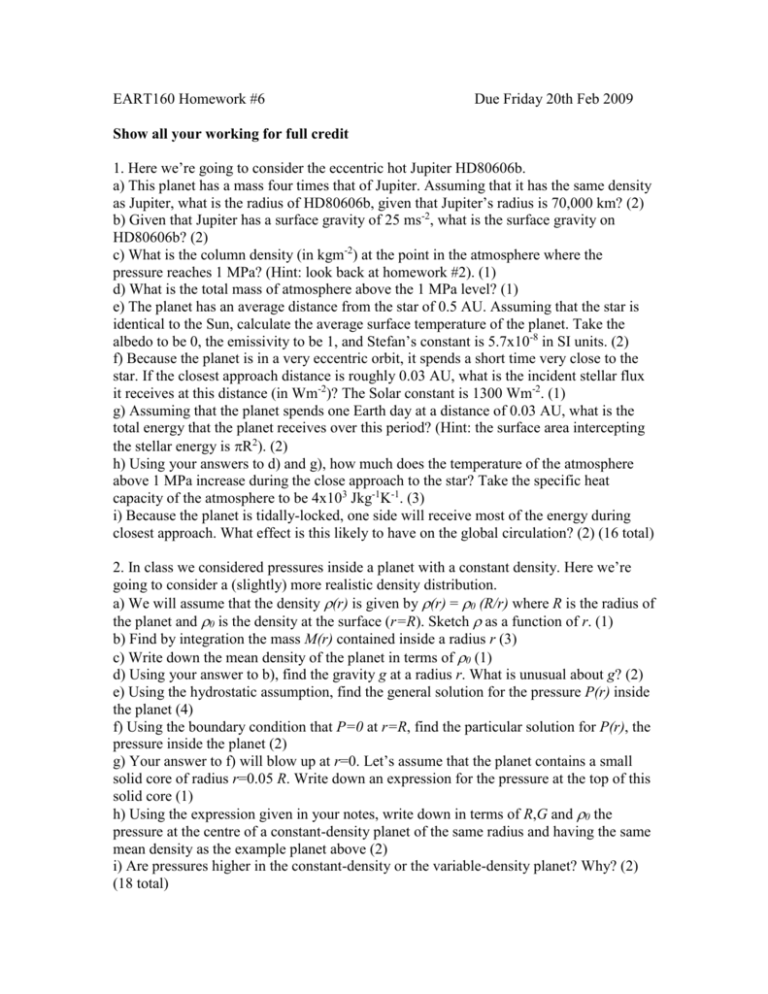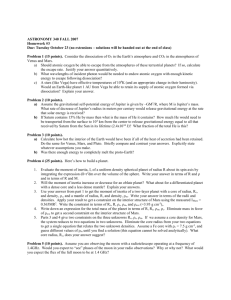Problem Set#6
advertisement

EART160 Homework #6 Due Friday 20th Feb 2009 Show all your working for full credit 1. Here we’re going to consider the eccentric hot Jupiter HD80606b. a) This planet has a mass four times that of Jupiter. Assuming that it has the same density as Jupiter, what is the radius of HD80606b, given that Jupiter’s radius is 70,000 km? (2) b) Given that Jupiter has a surface gravity of 25 ms-2, what is the surface gravity on HD80606b? (2) c) What is the column density (in kgm-2) at the point in the atmosphere where the pressure reaches 1 MPa? (Hint: look back at homework #2). (1) d) What is the total mass of atmosphere above the 1 MPa level? (1) e) The planet has an average distance from the star of 0.5 AU. Assuming that the star is identical to the Sun, calculate the average surface temperature of the planet. Take the albedo to be 0, the emissivity to be 1, and Stefan’s constant is 5.7x10-8 in SI units. (2) f) Because the planet is in a very eccentric orbit, it spends a short time very close to the star. If the closest approach distance is roughly 0.03 AU, what is the incident stellar flux it receives at this distance (in Wm-2)? The Solar constant is 1300 Wm-2. (1) g) Assuming that the planet spends one Earth day at a distance of 0.03 AU, what is the total energy that the planet receives over this period? (Hint: the surface area intercepting the stellar energy is R2). (2) h) Using your answers to d) and g), how much does the temperature of the atmosphere above 1 MPa increase during the close approach to the star? Take the specific heat capacity of the atmosphere to be 4x103 Jkg-1K-1. (3) i) Because the planet is tidally-locked, one side will receive most of the energy during closest approach. What effect is this likely to have on the global circulation? (2) (16 total) 2. In class we considered pressures inside a planet with a constant density. Here we’re going to consider a (slightly) more realistic density distribution. a) We will assume that the density (r) is given by (r) = 0 (R/r) where R is the radius of the planet and 0 is the density at the surface (r=R). Sketch as a function of r. (1) b) Find by integration the mass M(r) contained inside a radius r (3) c) Write down the mean density of the planet in terms of 0 (1) d) Using your answer to b), find the gravity g at a radius r. What is unusual about g? (2) e) Using the hydrostatic assumption, find the general solution for the pressure P(r) inside the planet (4) f) Using the boundary condition that P=0 at r=R, find the particular solution for P(r), the pressure inside the planet (2) g) Your answer to f) will blow up at r=0. Let’s assume that the planet contains a small solid core of radius r=0.05 R. Write down an expression for the pressure at the top of this solid core (1) h) Using the expression given in your notes, write down in terms of R,G and 0 the pressure at the centre of a constant-density planet of the same radius and having the same mean density as the example planet above (2) i) Are pressures higher in the constant-density or the variable-density planet? Why? (2) (18 total)









